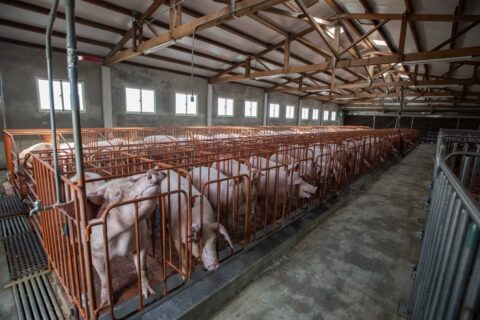Feature
Maine Was First to Ban Spreading PFAS-Contaminated Sludge on Farmland. Now Sludge Is Filling up Landfills.
Health•19 min read
Perspective
As long as humans insist on abusing and exploiting animals on factory farms, stronger and deadlier pathogens than the novel coronavirus will emerge from the global food system.


Words by Shad Clark
In everyday life, if you eat something that makes you sick, you don’t keep eating it. But what if your food choices keep making other people sick? Call it consequences or call it karma, but the deadliest diseases in modern history are the spoils of our food choices. HIV/AIDS and Ebola both resulted from people killing and eating other primates. The unsanitary conditions inherent in industrialized pig farms gave us H1N1, a.k.a. the swine flu. Our first taste of SARS came from a restaurant offering live animals—civet cats, raccoons, and badgers—to be butchered on-demand. And now the sequel, SARS CoV-2, the virus behind COVID-19, comes to us as a byproduct of a “wet market” where live animals are sold and slaughtered “fresh.” Time and again, all around the world, when these deadly diseases erupt, they are a natural response to the unnatural strain and abuses humans inflict on other species.
For every species, survival has always meant adapting to new threats. Long ago, armadillos evolved armor to shield themselves from predators. Porcupines grew quills for protection. Many other animals—chameleons, leopards, owls, geckos, along with various snakes and insects—developed their own natural camouflage. While we tend to think of evolution as a process that occurs over long periods of time, elephants are now quickly evolving without tusks in order to survive the rampant resurgence of ivory poaching. Today, we’re witnessing the evolutionary consequences of human activity playing out in real-time. But, it’s what we’re not seeing—or refusing to see—that’s killing us.
No animal is a lone organism. Each creature plays host to ecosystems of microorganisms, and most microbes are beneficial, like those in the immune system that work to protect the host animal, whether a pig or a person, from harmful germs. If overworked and outmatched, particularly if confronted with a newly evolved, or novel, pathogen, the immune system weakens and the host becomes sick.
On factory farms, animals are relentlessly stressed, abused, and forced to live in their own filth. In these conditions, illness is inevitable, and so meat producers put farmed animals on heavy regimens of drugs. These drugs aren’t to protect the animals so much as the industry’s bottom line. Even still, nature finds a way. Pathogens, like all bacteria and viruses, multiply much faster than animals, which means they evolve faster, too. To survive the industry’s best efforts to kill them, pathogens are forced to grow more resilient and robust with each new strain. This is how the swine flu was born. H1N1 killed 12,469 people in the U.S. and as many as 575,400 people worldwide. COVID-19 is now infecting and killing people at a much higher rate than the swine flu.
Instead of housing one intensely farmed species pumped full of super drugs, wet markets, like the one where COVID-19 emerged, operate like edible zoos. The live menus offer a range of wildlife—poached and farmed—including wolf puppies, peacocks, pangolins, bats, hedgehogs, foxes, donkeys, deer, ostriches, boars, and turtles, among many others, as well as dogs. Meat vendors heap these live caged animals haphazardly together—and brutally kill and slaughter them in front of each other, exacerbating their stress. While live animals already host their share of microbes, dead meat hosts even more. In the wet market, pathogens—viruses, bacteria, and parasites—are free to mingle and compete and test-drive potential new hosts. Though the latest novel coronavirus appears to have started in bats (who aren’t affected), COVID-19 likely jumped to pangolins and quite obviously jumped to humans, where it became deadly. The outbreak was inevitable—and entirely preventable. We were warned, and we knew better.
Like all other organisms, humans have the capacity to adapt and evolve. But we resist change and try, in vain, to force nature to adapt to us. We tell ourselves that our own species sits high atop the food chain. Yet it takes only a single germ to turn civilization upside-down, put entire countries in self-quarantine, threaten widespread economic collapse, and kill thousands of our family, friends, and neighbors. How many have to die before we stop eating animals?
Exploiting and killing animals is a messy business in every conceivable way, not the least of which is how it’s ravaging the planet. As long as we insist on abusing and exploiting animals, we’ll keep cultivating stronger and deadlier pathogens. Meanwhile, no pandemic has ever stemmed from people eating broccoli or blueberries or seitan. Vegetables, fruits, grains, legumes, and nuts—the foods we’re better evolved to eat—don’t bleed and breathe diseases that threaten to infect our family and friends. If we want our loved ones to live, it’s time we eat like it.